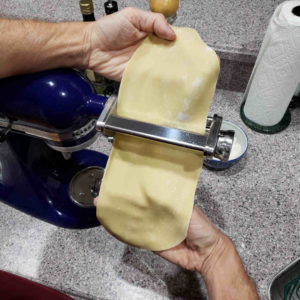
Fresh Pasta (Egg Based)
Egg based fresh pasta is your go to recipe when you plan on rolling and cutting or rolling and stuffing. If you plan on forming pasta shapes by hand without involving a roller, then you should use a semolina based fresh pasta recipe.
Equipment
- Food Processor (recommended)
- Pasta Roller (recommended)
Ingredients
- 2 cups all purpose flour see notes
- 3 grams salt see notes
- 3 large eggs see notes
Instructions
Manual Mixing Option
- Make a mound with the flour on a clean working surface, add the salt, stir to loosely mix the salt into the flour.
- Reform the mound, then hollow out the center of the mound to form a well and pour the three eggs into the well.
- Using a fork, whisk the eggs, slowly incorporating flour into the eggs while maintaining the walls of the well. If the wall breaks and the volcano erupts, it's not a terrible thing. Just keep working as best you can.
- Eventually there isn't enough flour remaining to provide a containment well, and the egg/flour mixture is solid enough that you can switch to using your hands to mix things into a loose clump of dough.
Mechanical Mixing Option
- Add the flour and salt in a food processor and give a quick pulse to mix the salt into the flour.
- Add the eggs and turn on the processor. Optimally a loose ball of dough with some straggling pellets gets formed. If pellets form, but they don't come together, drizzle water into the processor a teaspoon at a time. Each time, wait 15 seconds to see if a loose ball is formed. If a tight ball is formed and rides above the blades of the processor, the dough is probably on the wet side. This can be fixed during the kneading process.
Knead the Dough
- Knead the dough by repeatedly folding one portion of the dough over the rest of the dough ball, pressing the dough together, turning one quarter, and repeating.
- If you find that the dough cracks as you knead, more water is required. Add water very slowly by wetting your hands and letting the water from the surface of your hands work into the dough as you continue to knead.
- If you have kneaded the dough substantially and it continues to stick to your hands, the dough is too wet. Add flour very slowly by dusting the outside of the dough ball and working that flour into the dough as you continue to knead.
- Continue to knead the dough until its gluten matrix is well formed. You should find that the dough springs back when you remove your finger after pressing your finger into it.
Rest the Dough
- When you are done kneading the dough, form it into a tight ball and wrap it in plastic wrap. Optimally, allow the dough to rest for two hours before rolling.
Roll and Cut the Dough
- You can roll the dough using a rolling pin (or a wine bottle for that matter), or with a hand crank pasta roller, or with a pasta rolling attachment for a stand mixer. You can cut the pasta with a knife, or with the cutting attachments for the hand crank pasta roller or the stand mixer attachment. This is totally up to you, the equipment at your disposal and your intended application!
Notes
- Different brands and varieties of salt have very different weight to volume ratios. Diamond Crystal brand kosher salt (one of the lightest options) yields about 3 grams per teaspoon.
- There are a lot of variables in the optimal flour to egg ratio, including the level of residual moisture content in the flour and the humidity of the room. There is no perfect measurement. A more precise, but still not guaranteed measurement is to weigh the three eggs and then add enough water to reach 285 grams of liquid weight. Use this with 300 grams of flour. You still may need to make adjustments as described in the recipe, but the odds are more in your favor that the dough will have a correct hydration without adjustment.
Tried this recipe?Let us know how it was!